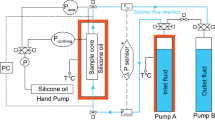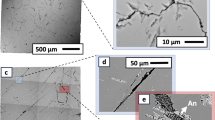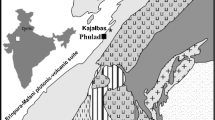Abstract
We evaluate balanced metasomatic reactions and model coupled reactive and isotopic transport at a carbonatite-gneiss contact at Alnö, Sweden. We interpret structurally channelled fluid flow along the carbonatite-gneiss contact at ∼640°C. This caused (1) metasomatism of the gneiss, by the reaction: \({\hbox{biotite} + \hbox{quartz} + \hbox{oligoclase} + \hbox{K}_{2} \hbox{O} +\,\hbox{Na}_{2}\hbox{O} \pm \hbox{CaO} \pm \hbox{MgO} \pm \hbox{FeO} = \hbox{albite} + \hbox{K-feldspar} + \hbox{arfvedsonite} + \hbox{aegirene-}\hbox{augite} + \hbox{H}_{2} \hbox{O} + \hbox{SiO}_{2}}\), (2) metasomatism of carbonatite by the reaction: calcite + SiO2 = wollastonite + CO2, and (3) isotopic homogenization of the metasomatised region. We suggest that reactive weakening caused the metasomatised region to widen and that the metasomatic reactions are chemically (and possibly mechanically) coupled. Spatial separation of reaction and isotope fronts in the carbonatite conforms to a chromatographic model which assumes local calcite–fluid equilibrium, yields a timescale of 102–104 years for fluid–rock interaction and confirms that chemical transport towards the carbonatite interior was mainly by diffusion. We conclude that most silicate phases present in the studied carbonatite were acquired by corrosion and assimilation of ijolite, as a reactive by-product of this process and by metasomatism. The carbonatite was thus a relatively pure calcite–H2O−CO2–salt melt or fluid.










Similar content being viewed by others
References
Andersen T (1996) Sr, Nd and Pb isotopic data of the Alnö complex 22nd Nordic Geological Winter Meeting, Abstract, vol 11
Bailey DK (1974) Nephelinites and ijolites. In: Sörensen H (ed) The alkaline rocks. Wiley, New York, p 622
Bear J (1972) Dynamics of fluids in porous media. Elsevier, Amsterdam
Bickle MJ, Baker J (1990) Advective-diffusive transport of isotopic fronts: an example from Naxos, Greece. Earth Planet Sci Lett 97:78–93
Brögger (1921) Die Eruptivgesteine des Kristianiagebietes, IV. Das Fengebiet in Telemark, Norwegen Vidensk Selsk Skrift I, Mat-Naturv Klasse, 9
Chiba H, Chacko T, Clayton RN, Goldsmith JR (1989) Oxygen isotope fractionations involving diopside, forserite, magnetite and calcite: applications to geothermometry. Geochim Cosmochim Acta 53:2985–2995
Church AA, Jones AP (1995) Silicate-carbonate immiscibility at Oldoinyo Lenagi. J Petrol 36:869–889
Eckermann H (1948) The alkaline district of Alnö Island. Sver Geol Unders Ca 36:1–176
Einaudi MT, Burt DM (1982) Introduction; terminology, classification, and composition of skarn deposits. Econ Geol 77:745–754
Ferry JM, Dipple GM (1991) Fluid flow, mineral reactions, and metasomatism. Geology 19:211–214
Gresens RL (1967) Composition-volume relationships of metasomatism. Chem Geol 2:47–65
Haynes EA, Moecher DP, Spicuzza MJ (2003) Oxygen isotope composition of carbonates, silicates, and oxides in selected carbonatites; constraints on crystallization temperatures of carbonatite magmas. Chem Geol 193:43–57
Hode Vuorinen J, Skelton ADL (2004) Origin of silicate minerals in carbonatites—in situ crystallisation or wall rock contamination? Terra Nova 16:210–215
Hode Vuorinen J, Hålenius U, Whitehouse MJ, Mansfeld J, Skelton ADL (2005) Compositional variations (major and trace elements) of clinopyroxene and Ti-andradite from pyroxenite, ijolite and nepheline syenite, Alnö Island, Sweden. Lithos 81:55–77
Hoffbauer R, Hoernes S, Fiorentini E (1994) Oxygen isotope thermometry based on a refined increment method and its application to granulite–grade rocks from Sri Lanka. In: Raith M, Hoernes S (eds), Tectonic, metamorphic and isotopic evolution of deep crustal rocks, with special emphasis on Sri Lanka. Precambrian Res 66:199–220
Holland TJB, Powell R (1998) An internally consistent thermodynamic dataset for phases of petrological interest. J Metamorph Geol 16:309–344
Jaeger JC (1968) Cooling and solidification of igneous rocks. In: Hess HH, Poldervaart A (eds), Basalts, the poldervaart treatise on rocks of basaltic composition. Wiley, New York, pp 503–537
Kramm U (1994) Isotope evidence for ijolite formation by fenitization: Sr–Nd data of ijolites from the type locality Iivaara. Finl Contrib Mineral Petrol 115:279–286
Kresten P (1979) The Alnö complex: discussion of the main features, bibliography and excursion guide Nordic Carbonatite Symposium, pp 67
Kresten P (1980) The Alnö complex; tectonics of dyke emplacement. Lithos 13:153–158
Kresten P, Morogan V (1986) Fenitization at the Fen complex, southern Norway. Lithos 19:27–42
Krynicki K, Green CD, Sawyer DW (1979) Pressure and temperature dependence of self-diffusion in water. Faraday Discuss Chem Soc 66:199–208
Lapidus L, Amundson NR (1952) Mathematics of adsorption in beds. IV. The effect of longitudinal diffusion in ion exchange and chromatographic columns. J Phys Chem 56:984–998
Macaulay CI, Fallick AE, Haszeldine RS, Graham CM (2000) Methods of laser-based stable isotope measurement applied to diagenetic cements and hydrocarbon reservoir quality. Clay Minerals 35:313–322
Morogan V, Lindblom S (1995) Volatiles associated with the alkaline—carbonatite magmatism at Alnö, Sweden: a study of fluid and solid inclusions in minerals from the Långarsholmen ring complex. Contrib Mineral Petrol 122:262–274
Morogan V, Woolley AR (1988) Fenitization at the Alnö carbonatite complex, Sweden: distribution, mineralogy and genesis. Contrib Mineral Petrol 100:169–182
Pak TM, Hauzenberger CA, Baumgartner LP (2003) Solubility of the assemblage albite+K-feldspar+andalusite+quartz in supercritical aqueous chloride solutions at 650 degrees C and 2 kbar. Chem Geol 200:377–393
Plas L van der, Tobi AC (1965) A chart for judging the reliability of point counting results. Am J Sci 263:87–90
Sharp ZD (1990) A laser-based microanalytical method for the in situ determination of oxygen isotope ratios in silicates and oxides. Geochim Cosmochim Acta 54:811–822
Sindern S, Kramm U (2000) Volume characteristics and element transfer of fenite aureoles: a case study from the Iivaara alkaline complex. Lithos 51:75–93
Sokolova NT, Khodakovskiy IL (1977) The mobility of aluminium in hydrothermal systems. Geochem Int 14:105–112
Taylor HP (1968) The oxygen isotope geochemistry of igneous rocks. Contrib Mineral Petrol 19:1–71
Taylor HP, Frechen J, Degens RT (1967) Oxygen and carbon isotope studies of carbonatites from the Laacher See district, West Germany, and the Alnö district, Sweden. Geochim Cosmochim Acta 31:407–430
Verschure RH, Maijer C (2005) A new Rb–Sr isotopic parameter for metasomatism, Δt, and its application in a study of pluri-fenitized gneisses around the Fen ring complex, South Norway. NGU Bull 445:45–71
Acknowledgments
This project was supported by Stockholm University and Stiftelsen Lars Hiertas Minne. Klara Hajnal is thanked for analytical work. Colin Graham is thanked for useful discussions about some of the ideas presented in this study. Tom Andersen, Rainer Abart and Ian Parsons are thanked for constructive input on earlier versions of this manuscript.
Author information
Authors and Affiliations
Corresponding author
Additional information
Communicated by J. Hoefs.
Appendices
Appendix 1: Table of symbols, recurring in this manuscript
Symbol | Description | Units |
|---|---|---|
C f | Concentration of the tracer in the fluid at z | |
C s | Concentration of the tracer in the solid at z | |
Cs,1, Cs,2 | Concentrations of the tracer in the solid upstream and downstream of the front | |
K V | Fluid solid partition coefficient by volume | |
ρ | Density | gcm−3 |
T | Time | s |
z | Distance | m |
zp.b. | Position of the pinned boundary | m |
X j (ork) | Modal% of reactant mineral j (or product mineral k) | |
nj (ork) | Number of moles of reactant mineral j (or product mineral k) per unit volume of rock | mol m−3 |
N I | Metasomatic addition (positive) or subtraction (negative) of component I per unit volume of rock | mol m−3 |
[i]j (ork) | Molar proportion of component i in reactant mineral j (or product mineral k) | |
N | Modal% of rock involved in the reaction | |
ξ | Reaction progress | |
ϕ | Porosity | |
ω | Fluid velocity | m s−1 |
ω ϕ | Fluid flux rate | m3 m−2 s−1 |
ωϕ·t | Time-integrated volumetric fluid flux | m3 m−2 (or m) |
D f | Diffusivity in the fluid | m2 s−1 |
τ | Tortuosity | |
\({{\sqrt {{D}_{\rm f} \varphi {\tau} \cdot {\hbox{t}}}}}\) | Characteristic length scale of diffusion | m |
Appendix 2: Parameterisation of goodness-of-fit
The goodness-of-fit is parameterised by R 2 a . This is the adjusted coefficient of multiple determination, which is given by:
for equation (4) rewritten as (7), with k = number of regression parameters, n = number of data points and \({{\sum\limits_{i = 1}^n {{\left({y_{i} - \bar{y}} \right)}^{2}}}}\) = total variation of parameter y. R 2a is the fraction of the variance in y which is explained by the model, y(z i; ωϕ·t, \({{\sqrt {D_{{\rm f}} \varphi \tau \cdot t}}},\) z p.b.) and can vary between 0 and 1.
Rights and permissions
About this article
Cite this article
Skelton, A., Hode Vuorinen, J., Arghe, F. et al. Fluid–rock interaction at a carbonatite-gneiss contact, Alnö, Sweden. Contrib Mineral Petrol 154, 75–90 (2007). https://doi.org/10.1007/s00410-007-0180-1
Received:
Accepted:
Published:
Issue Date:
DOI: https://doi.org/10.1007/s00410-007-0180-1




